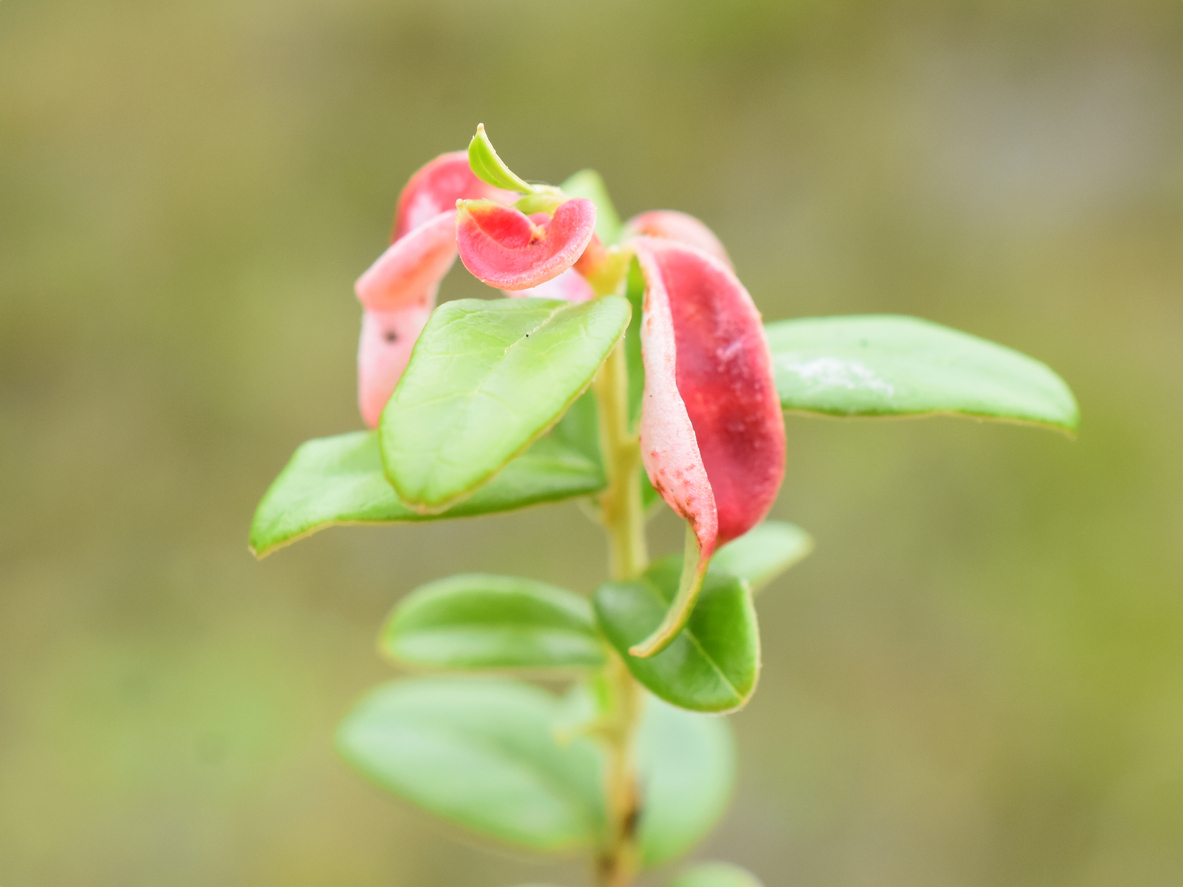
Leaf gall caused by fungus on a cranberry plant
Like all food crops, cranberries are susceptible to various fungal diseases. Your best weapons against these are best planting practices, which help prevent disease in the first place.
This is especially important, as there are no fungicides approved for home use for many plant diseases.
These best practices are aimed at producing strong, healthy plants that can withstand disease—and at avoiding situations that contribute to the development of disease. They involve keeping plants clean, dry, and undamaged.
Mulch: Mulch can help with water retention. The ideal mulch for cranberries is sand. This has the added benefit of not retaining moisture, so it’s inhospitable to fungal infections.
Watering: Water your cranberries deeply about once a week (check the soil for dryness). Do not over-water. Soggy soil invites disease.
Other best practices include:
- Buy healthy, disease-free plants from reputable sources.
- Plant your cranberries in full sun.
- Plant in sites with good drainage.
- Check plants regularly for signs of disease.
Common cranberry diseases
Here are some of the usual culprits that might infest your cranberry plants. Remember, it’s important to remove infected plant material (leaves, roots) to prevent the spread of disease once it’s found its way onto your plant.
Botryosphaeria Fruit Rot and Berry Speckle
Cause: Fungus
Symptoms:
- small, light-colored lesions on the berry skin
- on green berries, lesions appear as red rings
- berries develop a watery rot after harvest
How it spreads:
- rain or wind
Treatment:
- remove and discard infected plant material
Prevention:
- buy disease-free plants
- avoid watering from above; water at soil level
- make sure plants have good air circulation and lots of sun
End Rot
Cause: Fungus
Symptoms:
- soft watery rot with clear boundaries; can start at either end of the berry
- rot eventually covers entire berry, making it soft
- upper leaf surfaces may develop red-brown spots with tan or gray centers and black borders; areas beyond the black borders turn bright red
- leaf drop
How it spreads:
- fungus overwinters in stems, vines, dead leaves, and rotting fruit
Treatment:
- remove and discard infected plant material
- do not compost infected plant material
Prevention:
- usually shows up after berry harvest; refrigerating berries can stop development of the infection
False Blossom
Cause: Phytoplasma (single-cell organism) spread by leafhoppers
Symptoms:
- abnormal flowers that do not set fruit
- blossoms may be dark pink or streaked with red
- flower stalks stick straight up instead of arching
- infected uprights (stems) may have a witches’ broom appearance
How it spreads:
- blunt-nosed leafhopper spreads infection from one plant to another when it feeds on the plant
Treatment:
- dig out infected vines, including the roots
Prevention:
- set traps for leafhoppers
- use floating row covers
Phytophthora Root and Runner Rots
Cause: Oomycetes (fungus)
Symptoms:
- plants not thriving
- weak, unproductive, or dead vines
- leaves turn yellow, then red, then collapse
- reduced flower and fruit production
- discolored roots
How it spreads:
- poorly drained soil
- overwatering
Treatment:
- remove and discard infected material
- apply fungicide as necessary
- fertilize plants to stimulate root growth
Prevention:
- plant in well-draining soil
- do not overwater
- increase drainage
- add sand to soil
Proventuria Early Leaf Spot
Cause: Fungus
Symptoms:
- red circles or rings on the upper surfaces of leaves
- marks darken as fungus multiplies
How it spreads:
- fungus overwinters in infected plant material
- wind, insects, and birds
Treatment:
- remove and destroy infected areas
Prevention:
- liquid copper fungicide
- plant disease-resistant varieties
- remove plant debris
Red Leaf Spot
Cause: Fungus
Symptoms:
- circular spots on the upper surface of leaves
- spots on young berries
How it spreads:
- fungus overwinters on infected leaves and stems
- high humidity, including fog and heavy rain
Treatment:
- remove and discard infected parts
- apply foliar fungicides
Prevention:
- spray with Bordeaux mixture after buds break in the spring
- avoid overfertilizing
Which diseases have you had to treat on your cranberries? Please tell us how you prevent and handle diseases. If you spot other symptoms on your cranberries that are not mentioned here, contact your local extension center or garden center for a consult—and please let us know what you discover by commenting below.


 Previous
Previous

